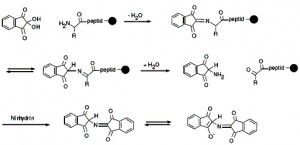As is seen, polypeptide synthesis is connected with mass chemical substances such as amino acids. Therefore, some people were wondering whether the synthesis process can promote the stability of amino acids to a certain degree. Actually, polypeptide synthesis is a repeat of the process to add amino acids, solid phase synthesis generally from C-terminal sequence to N-terminus. Solid phase synthesis method has greatly reduced the difficulty in purifying products at each step.
 In order to prevent the occurrence of side reactions, it is necessary to protect the side chains of amino acids that participate in the reaction. The carboxy terminus is free, and must be activated before the reaction. To be more specific, two main methods of solid phase synthesis are used in applications, namely Fmoc and tBoc. And because Fmoc owns more advantages than tBoc, now researchers mostly utilize Fmoc synthesis. When it comes to specific synthesis cycle, it mainly consists of the following components:
In order to prevent the occurrence of side reactions, it is necessary to protect the side chains of amino acids that participate in the reaction. The carboxy terminus is free, and must be activated before the reaction. To be more specific, two main methods of solid phase synthesis are used in applications, namely Fmoc and tBoc. And because Fmoc owns more advantages than tBoc, now researchers mostly utilize Fmoc synthesis. When it comes to specific synthesis cycle, it mainly consists of the following components:
1. Protection: protective pillars and monomers must remove the amino group’s protection gene by using an alkaline solution (piperidine).
2. Activation and crosslinking: carboxyl group of next amino acid is activated by an activating agent. Activated monomer connecting with the free amino crosslinking can form a peptide bond. In this step, a large number of super-concentration reagents that can drive the reaction effectively are indispensable. As for the cycle, it means it’s a two-step reaction cycle, which should keep repeating until the synthesis is completed.
3. Elution and deprotection: peptides elute from the column, and the protecting group is eluted and deprotected by a deprotecting agent (TFA).
Actually, during the process of polypeptide synthesis, ammonium lactate, bradykinin, C peptide and some other substances might be stressed more. In addition, the synthesis is connected with the selection of resin and fixation of amino acids. It’s common to know the most important feature of distinguishing solid phase synthesis and other techniques is solid support, because synthesis carrier that can be used for solid phase peptide must meet the following requirements: containing reactive sites, owning physically and chemically stable condition, allowing rapid and unimpeded contact between the growing peptide chain and reagents, and providing enough connection points. Therefore, each unit volume of the carrier can give a useful yield of peptides and the need to minimize the interaction of the polypeptide chains by carrier bound will be realized.
There are mainly three types can be widely used for solid phase synthesis: polystyrene-divinyl benzene crosslinked resins, polyacrylamide, and polyethylene-glycol based resins and derivatives. In terms of different reactive groups, the stability of amino acids could be varying, because the stability is realized by protecting carboxyl of amino acids and the reaction groups of resin. In summary, polypeptide synthesis is able to promote the stability of amino acids by protecting the covalent and certain other substances like amide bound.